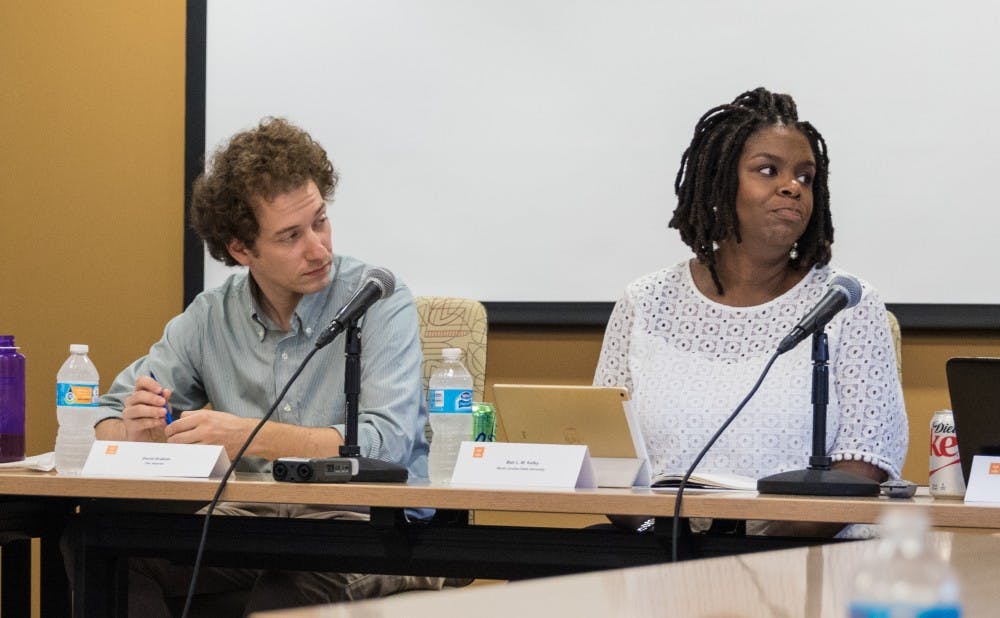Durham has been a hotbed of activity directed against its Confederate memorials, from the monument in front of the Durham County Courthouse to the Robert E. Lee statue at the entrance to the Chapel.
A panel Tuesday investigated the issue of Confederate monuments in both Durham and Baltimore. Hosted by the Forum for Scholars and Publics, the event featured David Graham, Trinity '09 and a journalist for The Atlantic, Blair Kelley, associate professor of history at North Carolina State University, and Martha Jones, The Society of Black Alumni professor of history at Johns Hopkins University.
“You can suddenly tie together what’s going on with police violence, what’s going on with the presidential administration and what’s going on with these statues all very easily,” Graham said.
He clarified that the post-Charlottesville protests directed toward the removal of statues were not a recent phenomenon, but rather a buildup of longstanding frustration.
“I do think that this isn’t totally new. We’ve been having fights about things like Monument Avenue in Richmond for years,” Graham said. “There was a spate of laws passed in the early 2000s that were designed to prevent monuments from being taken down.”
The panelists discussed these protective laws and whether they were effective at allowing citizens to express their desire to take down controversial monuments. In 2015, former North Carolina Governor Pat McCrory signed such a bill into law in North Carolina that prevented the removal of monuments, plaques or markers without the approval of the North Carolina Historical Commission.
Kelley noted that the process of removing a statue has shifted away from the local level and now rests with the state, thereby making Durham and other communities feel “less empowered” in deciding the fate of controversial monuments.
“If laws are written in a way that stunts the ability of the local communities to make decisions about the landscape of their town and their city, then who shut the conversation down?” Kelley asked.
Graham gave several examples of state authorities refusing to yield to local pressure to remove a monument. He mentioned statue of Nathan Bedford Forrest—a Confederate officer who murdered Union prisoners of war and was an early figure in the Klu Klux Klan—in Memphis, Tenn. The Tennessee Historical Commission refused to remove this statue, despite the support of Memphis’ mayor and city council.
The conversation also touched upon the value of monuments and memorials as historical lessons, and whether history would disappear as statues are taken down.
“I think monuments are teaching things—I think they’re teaching people that this is not your space,” Kelley said. “I love history—that’s what I do, but I’m pretty sure I don’t need giant metal statues to do that work.”
Jones added that even if all monuments were removed—something that is in “no danger” of happening—the extraordinary amount of Civil War literature in libraries would still be present to read and teach those who are interested in learning about the history.
As a professor at Johns Hopkins, Jones also spoke about Baltimore’s decision to remove four monuments in August. Although some regarded the move as a sneaky, undercover operation, the removal was in fact the final step of a comprehensive two-year process involving public hearings and expert testimony, she explained.
Jones used Baltimore as a model for how other cities might consider addressing Confederate monuments in the future. Even in settings where one cannot be removed, cities can install other figures near the original statue to create “dueling monuments.”
“The State House in Maryland has Frederick Douglass, Harriet Tubman and then—until recently—Roger Taney,” she said.
Douglass and Tubman both escaped from slavery and are considered heroes of the anti-slavery movement. Taney wrote the majority opinion in the Dred Scott Supreme Court case, which stated that slaves were not American citizens and had no right to sue in federal court.
Toward the end of the panel, an audience member emphasized the need for more public art to combat the symbolism of Confederate memorials. She also criticized Duke for hosting the talk on University grounds and “preaching to the choir” instead of venturing into the community to engage more people in the conversation.
Another member of the audience—a former Baltimore resident—noted that many residents had never paid attention to the Taney statue prior to its removal. She explained that taking down the Taney monument thus encouraged people to talk and think about a topic that they otherwise would ignore.
“There’s a violence that undergirds where these [monuments] come from,” Kelley said. “For me, that violence is still visible.”
Get The Chronicle straight to your inbox
Signup for our weekly newsletter. Cancel at any time.

